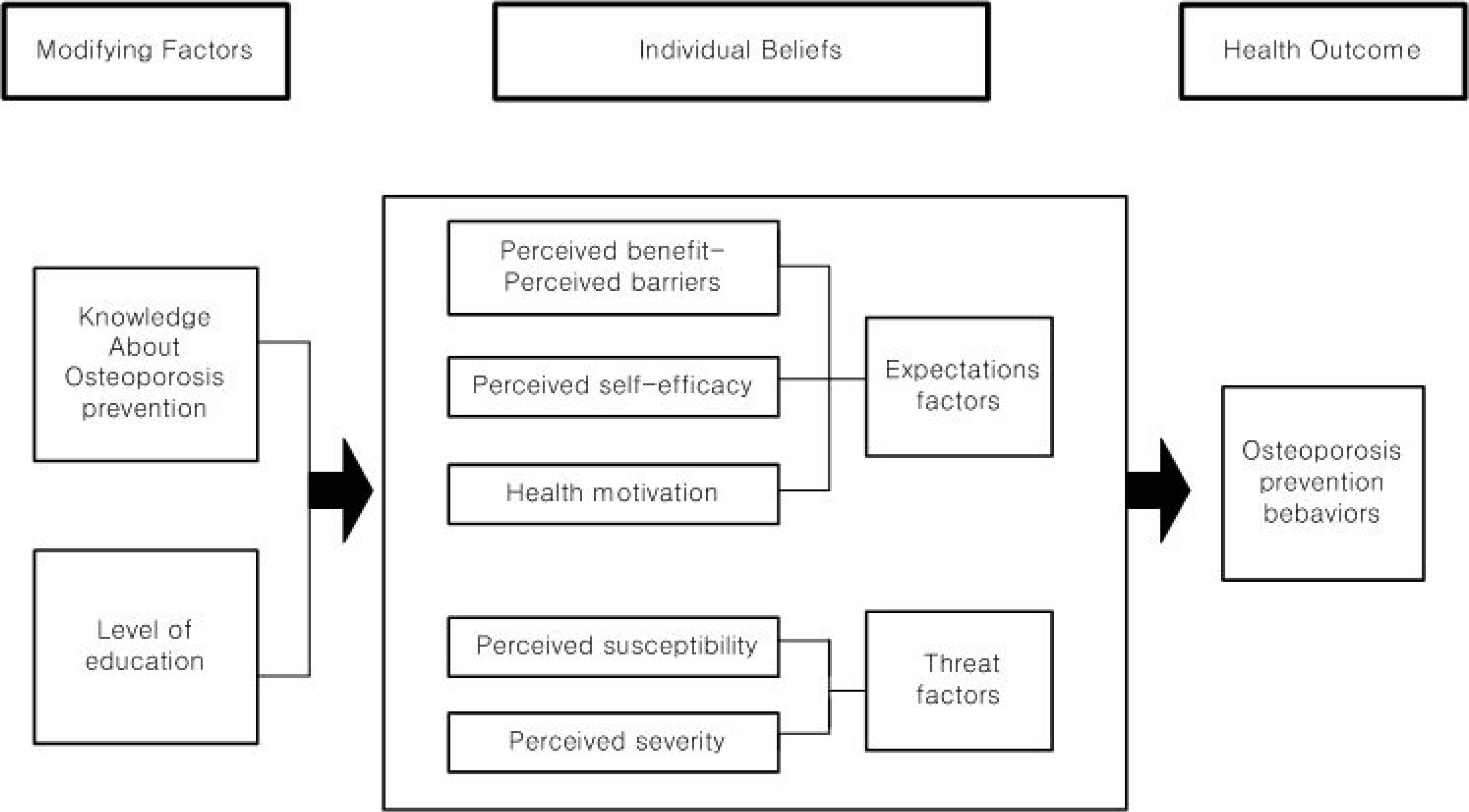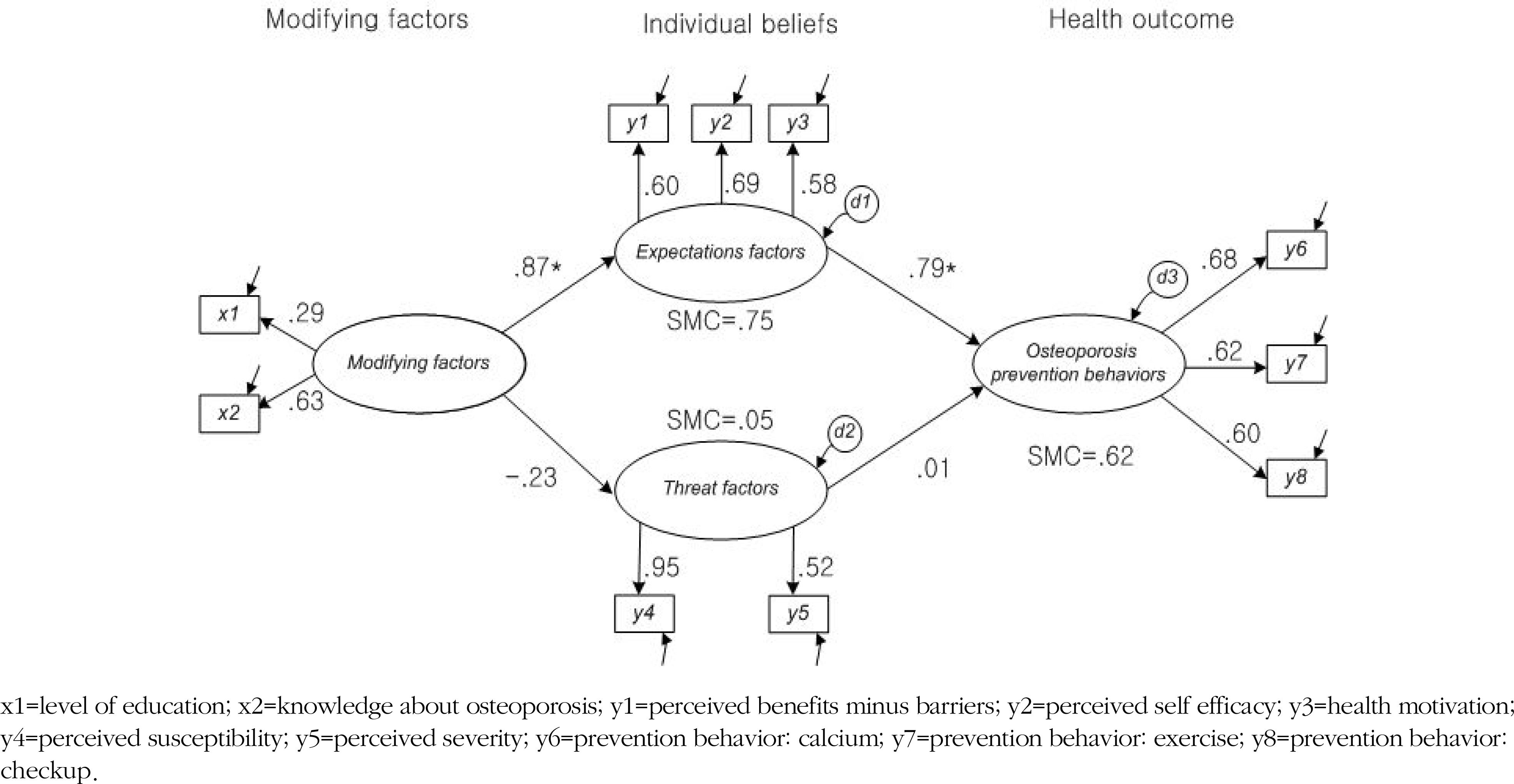Korean J Adult Nurs.
2015 Dec;27(6):624-633. 10.7475/kjan.2015.27.6.624.
An Equation Model Development and Test based on Health Belief Model Regarding Osteoporosis Prevention Behaviors among Postmenopausal Women
- Affiliations
-
- 1Department of Nursing, Kkottongnae University, Chungju, Korea.
- 2College of Nursing, Chungnam National University, Daejeon, Korea. sukheeahn@cnu.ac.kr
- KMID: 2221716
- DOI: http://doi.org/10.7475/kjan.2015.27.6.624
Abstract
- PURPOSE
This study was to develop and test a theoretical model based on the revised health belief model explaining osteoporosis prevention behaviors among postmenopausal women under 65.
METHODS
This secondary data analysis included 342 postmenopausal women under 65 from original data sources of a total of 734 women. The measured instruments were scales for osteoporosis awareness, osteoporosis health belief scale (benefit, barrier, susceptibility, severity, and health motivation), self-efficacy, and osteoporosis prevention behaviors. Data were analyzed using SPSS/WIN 20.0 and AMOS 20.0.
RESULTS
The mean age of the subjects was 55.2 years and the mean age of menopause was 51.10. The hypothetical model of osteoporosis prevention behaviors was relatively fit. Osteoporosis prevention behaviors were significantly explained up to 62% by expectation factors (relative benefit, self-efficacy, health motivation) and modifying factors(knowledge only). Expectation factors of health belief had a mediation effect between modifying factors and prevention behaviors.
CONCLUSION
This study partially supported the revised health belief model for explaining osteoporosis prevention behaviors. It provides a basis for developing an educational program focusing on expectation factors and knowledge with the aim of behavioral changes for osteoporosis prevention.
MeSH Terms
Figure
Cited by 1 articles
-
Relationships among Knowledge, Self-efficacy, and Health Behavior of Osteoporosis and Fall Prevention in Old Aged Women
Sukhee Ahn, Jiwon Oh
Korean J Women Health Nurs. 2018;24(2):209-218. doi: 10.4069/kjwhn.2018.24.2.209.
Reference
-
1.Statistics Korea. 2012 Life tables for Korea [Internet]. Daejeon: Author;2013. [cited 2013 December 20]. Available from:. http://kostat.go.kr/portal/korea/kor_nw/2/2/7/index.board.2.Nam HS., Kweon SS., Choi JS., Zmuda JM., Leung PC., Lui LY, et al. Racial/ethnic differences in bone mineral density among older women. Journal of Bone and Mineral Metabolism. 2013. 31(2):190–8. http://dx.doi.org/10.1007/s00774-012-0402-0.
Article3.Lee JS., Jang SO. A study on reference values and prevalence of osteoporosis in Korea: the Korea National Health and Nutrition Examination Survey 2008-2011. Journal of the Korean Official Statistics. 2013. 18(2):42–65.4.Moon ES., Lee ES. The relationship betweenknowledge, health beliefs, and prevention behaviors of osteoporotic fracture in patients receiving osteoporosis treatment. Korean Journal of Women Health Nursing. 2010. 16(2):147–56. http://dx.doi.org/10.4069/kjwhn.2010.16.2.147.5.Rosenstock IM., Strecher VJ., Becker MH. Social learning theory and the health belief model. Health Education Quarterly. 1988. 15:175–83.
Article6.Champion, V. L., Skinner, C.S.Thehealthbeliefmodel. 4thed.Glanz K, Rimer BK, Viswanath K, editors. Health behavior andhealtheducation: theory, research, and practice. SanFran-cisco: Jossey-Bass;2008. p. 49.7.Kim KK., Horan ML., Gendler P., Patel MK. Development and evaluationofthe osteoporosis health beliefscale. Research in Nursing & Health. 1991. 14(2):155–63.8.Horan ML., Kim KK., Gendler P., Froman RD., Patel MD. Devel-opmentand evaluationofthe osteoporosisself-efficacy scale. Research in Nursing & Health. 1998. 21(5):395–403. http://dx.doi.org/10.1002/(sici)1098-240x(199810)21:5<395::aid-nur3>3.0.co;2-i.9.Shin SJ., Shin KR., Yi HR., Ju SK. Knowledge, health belief, and self-efficacy related to osteoporosis. Journal of Korean Academy Nursing. 2005. 35(5):850–7.
Article10.Kim MH., Kim MS. Astudyontherelationships betweenknowledge about osteoporosis and cognitivefactors in middle-aged women. Korean Journal of Women Health Nursing. 2005. 11(1):52–7. http://dx.doi.org/10.1007/s10900-010-9263-4.11.Song HR., So HY. Effects of the knowledge, health belief, and self-efficacy about osteoporosis on calcium intake behavior for postmenopausalosteoporosis patients. Korean Journal of Adult Nursing. 2007. 19(5):80–91.12.Sedlak CA., Doheny MO., Estok PJ., Zeller RA., Winchell J. DXA, health beliefs, and osteoporosis prevention behaviors. Journal of Aging and Health. 2007. 19(5):742–56.
Article13.Shakil A., Gimpel NE., Rizvi H., Siddiqui Z., Ohagi E., Billmeier TM, et al. Awareness and prevention of osteoporosis among South Asian women. Journal of Community Health. 2010. 35(4):392–7. http://dx.doi.org/10.1007/s10900-010-9263-4.
Article14.Von Hurst PR., Wham CA. Attitudes and knowledge about osteoporosis risk prevention: a survey of New Zealand women. Public Health Nutrition. 2007. 10(7):747–53. http://dx.doi.org/10.1017/s1368980007441477.
Article15.Deo P., Nayak R., Rajpura J. Women's attitudes and health beliefs toward osteoporosis screening in a community pharmacy. Journal of Osteoporosis. 2013. 2013:650136. http://dx.doi.org/10.1155/2013/650136.
Article16.Zhang YP., Xia RY., Zhang B., Zhang F., Zhao XS., Zhang LL, et al. Gender differences on osteoporosis health beliefs and related behaviors in non-academic community Chinese. Journal of Community Health. 2014. 39(3):545–51. http://dx.doi.org/10.1007/s10900-013-9795-5.
Article17.Johnson CS., McLeod W., Kennedy L., McLeod K. Osteoporosis health beliefs among younger and older men and women. Health Education & Behavior. 2008. 35(5):721–33. http://dx.doi.org/10.1177/1090198107301331.18.McLeod KM., Johnson CS. Asystematicreviewofosteoporosis health beliefs in adult men and women. Journal of Osteoporosis. 2011. 2011:197454. http://dx.doi.org/10.4061/2011/197454.19.Lee SH. Prediction model on osteoporosis prevention behavior in middle aged women. [dissertation]. Seoul: Korea University;2006.20.Park YJ., Lee SJ., Shin NM., Kang HC., Kim SH., Kim T, et al. Structural model for osteoporosis preventive behaviors inpostmeno-pausal women: focused on their own BMD awareness. Korean Journal of Adult Nursing. 2013. 25(5):527–38. http://dx.doi.org/10.7475/kjan.2013.25.5.527.21.Estok PJ., Sedlak CA., Doheny MO., Hall R. Structural model for osteoporosis preventingbehavior inpostmenopausalwomen. Nursing Research. 2007. 56(3):148–58.22.Ahn SH., Kim YM., Chun NM., Lee SH. Incidenceofosteoporosis andfalls andpredictors offractureriskinpostmenopausalwo-men. Korean Journal of Women Health Nursing. 2012. 18(4):237–47. http://dx.doi.org/10.4069/kjwhn.2012.18.4.237.23.Kim GS. Analysis structural equation modeling. Seoul: Han-narae Publishing Co;2010.24.Wallace LS. Osteoporosis preventionin college women: application of the expanded health belief model. American Journal of Health Behavior. 2002. 26(3):163–72.25.Choi ES., Kim JH., Chung MY., Hwang KH. Development of an osteoporosis awareness scale for women. Journal of Korean Academy of Nursing. 2008. 38(6):813–21. http://dx.doi.org/10.4040/jkan.2008.38.6.813.
Article26.Doheny MO., Sedlak CA., Hall RJ., Estok PJ. Structural model for osteoporosis preventing behavior in men. American Journal of Men's Health. 2010. 4(4):334–43. http://dx.doi.org/10.1177/1557988309351953.
Article27.Jang HJ., Ahn SH. A predictive model of fall prevention behaviors in postmenopausal women. Journal of Korean Academy Nursing. 2014. 44(5):525–33. http://dx.doi.org/10.4040/jkan.2014.44.5.525.
Article
- Full Text Links
- Actions
-
Cited
- CITED
-
- Close
- Share
- Similar articles
-
- A Predictive Model of Fall Prevention Behaviors in Postmenopausal Women
- Structural Model for Osteoporosis Preventive Behaviors in Postmenopausal Women: Focused on their Own BMD Awareness
- The Relationship between Knowledge, Health Beliefs, and Prevention Behaviors of Osteoporotic Fracture in Patients receiving Osteoporosis Treatment
- Factors Related to Health Behaviors of the People in an Urban Community: Based on the Health Belief Model
- Development and Validation of a New Clinical Diagnostic Screening Model for Osteoporosis in Postmenopausal Women



